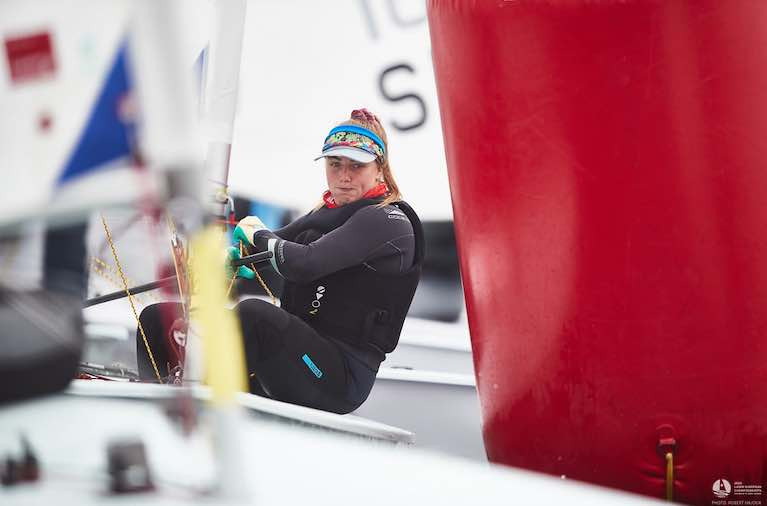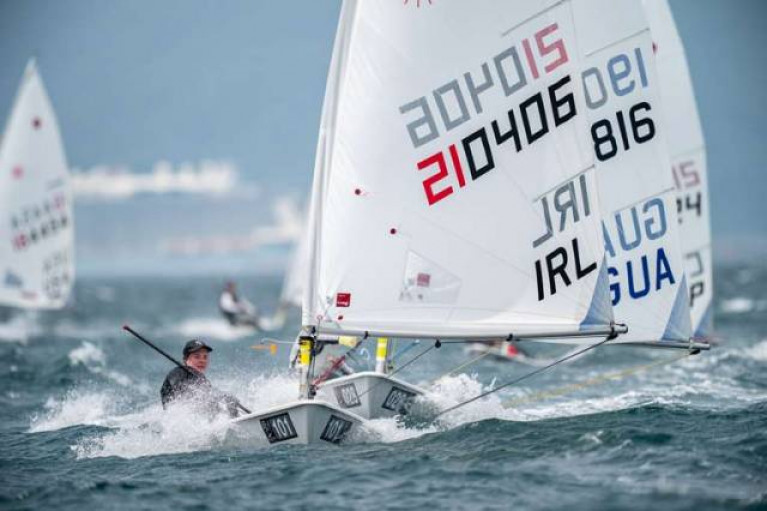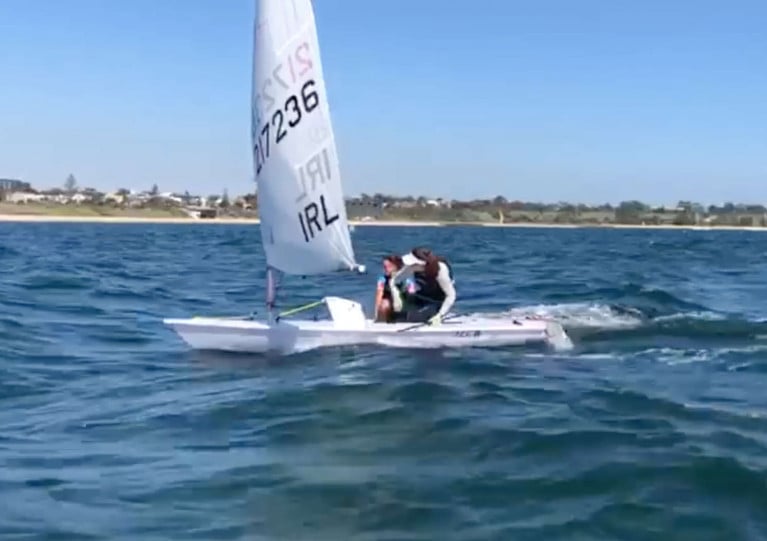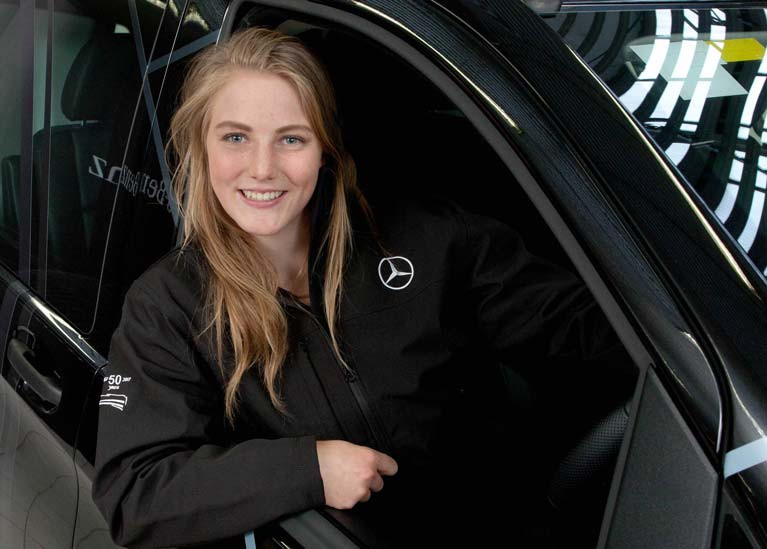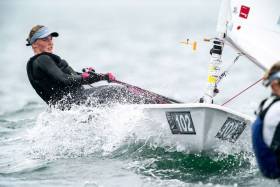Displaying items by tag: Aoife Hopkins
Howth Radial Sailor Aoife Hopkins Heads for Vilamoura Regatta With Mercedes Benz Support
Olympic ambition runs deep for Howth Radial sailor Aoife Hopkins. After the controversially cut short Olympic trial last year, the 22-year-old is back in her ILCA 6 dinghy and en route this weekend to the Vilamoura International Regatta in Portugal.
Her ongoing efforts have received a ’fair wind’ from Mercedes-Benz. The car manufacturer has renewed its ongoing support for the talented helmswoman who must now have an eye on Paris 2024 after the disappointment of Tokyo?
Hopkins is a former Women’s Laser Radial Irish national champion and under-21 European champion titleholder.
The UCD financial maths student says she will be training with Tokyo nominated Annalise Murphy (also sponsored by Mercedes) in the lead up to the Games now less than 100 days away.
It's a tricky time on the Olympic circuit as the Radial Europeans, Worlds and the important Princesa Sofia Palma have all been postponed to October due to COVID so there won’t be much racing but there is still th option of the Allianz regatta in the Netherlands in June, Hopkins told Afloat.
Both Murphy and Hopkins clubmate Eve McMahon are also entered for Vilamoura next week but there is no sign of Tipperary sailor Aisling Keller, the sailor who won the nation place for Ireland in Tokyo back in 2019.
November sunshine plays tricks with how we see things. Maybe it's because it's so rare. But at the weekend at Howth – with just a month to go to the shortest day of the year – a special coaching course being run in Lasers by international champion Aoife Hopkins was taking place with a low-slung sun so powerful – under a sky of a blue so utterly blue that it hasn't got a name yet – that an educational circuit of Ireland's Eye under the watchful Hopkins' eye did strange things to vision.
 Be careful in looking at this photo – when you get hold of the thought that the boat is going away and the sail is coming back again, the brain just won't let itself be re-set correctly
Be careful in looking at this photo – when you get hold of the thought that the boat is going away and the sail is coming back again, the brain just won't let itself be re-set correctly
Maybe it's just us, and maybe it's time we re-visited the pioneering HYC Brass Monkey Winter Series creator Pat Connolly in his day job as an optician. But if you look at the pic above of the trainee flotilla of Abby Kinsella, Una Connel, Fiachra Farrelly and Charlie Keating heading eastward towards the Martello tower and the cliffs along the north coast of Ireland's Eye, there's no doubt that the nearest boat is going away, but the strong low light somehow makes it look as though the sail is coming back again…….
Either way, in the idyllic circumstances a circuit of Ireland's Eye provided an ideal opportunity for a multi-layered day of training, as there was pilotage, navigation and useful wildlife observation added to the mix, even if The Stack on the northeast corner – a summertime Gannet Central since 1989 – was winter silent, with just one gannet watchman left behind.
 Closing in on The Stack on Ireland's Eye. In summer, it's Gannet Central...
Closing in on The Stack on Ireland's Eye. In summer, it's Gannet Central...
 ……..but off season, just one lone gannet has drawn the short straw to be The Winter Watchbird
……..but off season, just one lone gannet has drawn the short straw to be The Winter Watchbird
It was difficult to imagine the place in a harsh grey easterly, which in some Novembers is the default weather condition around Ireland's Eye. But in Howth, nothing is allowed to go to waste – as Aoife observed after winning the Laser U21 Euros 2017 at Douarnenez in Brittany in a week of extra-fresh westerlies, determined days of sailing in strong easterlies off Howth will set you up for anything, Breton westerlies included…..
 Aoife Hopkins winning the Laser Euro U21s in strong westerlies at Douarnenez in Brittany
Aoife Hopkins winning the Laser Euro U21s in strong westerlies at Douarnenez in Brittany
Annalise Murphy snatched a second place in today's final race of Women’s Laser Radial European Championships in Poland but that's as far as the good news went for Ireland's only sailor to be nominated (so far) for the Tokyo 2021 Olympics.
There’s no doubt the Rio silver medalist will be disappointed with her final position in 27th an event the National Yacht Club sailor previously won in 2013.
 Aoife Hopkins - 32nd overall in Poznan Photo: Thom Touw
Aoife Hopkins - 32nd overall in Poznan Photo: Thom Touw
Aoife Hopkins finished 32nd in gold fleet, while Howth clubmate Eve McMahon also had a solid event – at 16 years old (and a 2019 Under-17 Radial World Champion) she was by far the youngest in the fleet, and her qualification for the gold fleet and final position in 45th place is an indication of her bright future.
 Eve McMahon - at 16 the youngest sailor to make gold fleet at the Radial Europeans Photo: Thom Touw
Eve McMahon - at 16 the youngest sailor to make gold fleet at the Radial Europeans Photo: Thom Touw
Bouwmeester is Euro Champion
The reigning 2020 World and 2016 Olympic champion Marit Bouwmeester NED (2-1) surpassed the reigning 2019 European champion Anne Marie Rindom DEN (19-16) on the last day to be crowned the new 2020 Women’s Senior European champion for the fourth time in her career.
Anne Marie governed the fleet during the whole event but had a terrible day today, scoring her worst two races in the whole championship, ruining the 20 points lead she had this morning.
Marit looked revitalised instead after the Yellow flag penalty received yesterday, and after that DNC she scored her best 4-1-2-1 results to climb to the top and grab her name on both the Worlds and European titles this year.
"I knew that it would be very difficult. All I could do is sail as good as possible. I’ve sailed a great day and were lucky that Anne Marie had a difficult day. Which is obviously out of my control" – Marit Bouwmeester NED
“It was not my day today. I let my emotions affect me today and I sailed under my level. I’m very disappointed and sad but it’s a part of sport. I got to learn from it and come back stronger “, confessed Anne Marie Rindom (DEN)
The Bronze medal was finally for local sailor Agata Barwinska POL (15-7), overcoming Greek Vasileia Karachaliou GRE (29-14) by 5 points.
Results here
Aoife Hopkins Moves Ahead of Annalise Murphy in Penultimate Day of Radial Europeans
A dramatic turnaround - from an Irish perspective at least - saw Howth’s Aoife Hopkins move up to 32nd place in the 2020 Laser Radial Senior European Radial Championships in Poland today to overhaul Olympic silver medalist Annalise Murphy by a single place. Eve McMahon is in 40.
Three races were added to scores on Women’s Gold and Silver fleets but an overall disappointing one for Murphy dropping some 15 places overall from 18th on Sunday.
Racing started with 6-8 knots breeze from land on this second day of the Final series, raising then up to 12 knots for the last races.
It’s been a tricky competition with big variations in the offshore wind, and this shows in the high scores of the women’s Laser Radials but there is no mistaking the consistency of the top five who are among Murphy’s main rivals for Gold at next year’s Olympics in Tokyo.
The women’s fleet has two more races tomorrow that is forecast to be the breeziest of the series, so standby to see Ireland’s 'Breeze Queen' make an impact on Gdansk Bay in the final day's proceedings.
There has been some terrific sailing by the reigning 2019 European champion Anne Marie Rindom DEN (2-9-6), leading the championship from the beginning. She’s heading the fleet with 22 points after ten races and got a 20 points margin on second.
The second-placed sailor, however, is none other than the reigning 2020 World and 2016 Olympic champion Marit Bouwmeester NED (55 DNC-4-1), who scored her first win today on this event and a 4th after waiting aside during the first race due to Yellow flags received yesterday. So nothing is definite and the Gold medal title remains open.
Sailing conditions will be different tomorrow, although both sailors are Masters in all of them.
Third place is now for ascendant Vasileia Karachaliou GRE (9-1-11) with 51 points, only 9 behind Marit.
“My goal for today was to try to be in the top 10 and then try to climb up from there. I was really happy to be able to come back from mid-fleet position in the last race today. It was another really hard day, happy that I manage to survive. Thoughts for tomorrow are to try to stay calm and warm for tomorrow’s last day of the championship” – Vasileia Karachaliou GRE
Local sailor Agata Barwinska POL (16-17-23) couldn’t repeat yesterday’s great performance, dropping from 2nd to 4th with 53 points. Svenja Weger GER (3-12-25) is fifth with 67.
Two points separate the next 4 sailors, ranked 6th to 9th on provisional European Top 10: Maud Jayet SUI –76–, Josefin Olsson SWE –76.2–, Ecem Guzel TUR –78– and Emma Plasschaert BEL –78–. Maxime Jonker NED wraps this list, sharing 87 points with Silvia Zennaro ITA on the 11th place.
Canadian sailor Sarah Douglas CAN is best non-European sailor, holding the 6th place overall with 72 units.
Results here
Aoife Hopkins will not appeal last week’s decision to cut-short the Radial Olympic trial for Tokyo 2021 as Howth Yacht Club, expressed its disappointment for both the former U21 European Champion and clubmate Eve McMahon, both contestants in the Irish trials.
Irish Sailing announced its decision to select Rio silver medalist Annalise Murphy, after only one of a series of three trials had been sailed.
Hopkins (21), who was Murphy's (30) nearest rival for the single Tokyo berth, was left 'devastated' last week when the trials were stopped.
"I really can’t understand the decision not to continue with the trials. I am utterly and completely devastated", she told Afloat after the decision.
Speaking at the weekend, Howth Yacht Club Commodore Ian Byrne told Afloat 'Our club is naturally disappointed for Aoife and Eve and that they didn’t get the chance to follow through with their campaigns'.
Under the selection process, if one or more of the trial regattas are cancelled, then the person with the best performance in the completed trial regattas secures the nomination.
Murphy finished the ILCA Laser Radial Women’s World Championship in 12th place, Hopkins finished in 40th, Aisling Keller 63rd, and Academy sailor McMahon 78th.
The manner in which the decision was made and conveyed to Hopkins took her and supporters aback last Monday, (including some sponsors), given that the Olympics is still a year away, adding heft to her argument there was plenty of time to complete the trials series among the four Irish contestants.
Hopkins club has expressed its disappointment at the decision despite the fact that the Rio silver medalist may have set a tough target for the others after a top placing at February's World Championships.
Hopkins is arguably the most affected by the decision, given the length of her campaign and also that she might have expected to be in Tokyo, before Annalise’s return to the class after she gave up on the 49er FX last September.
Hopkins also had a club rival in young Academy sailor Eve McMahon who had been given the chance to contest the trial as a 16-year-old, so the Radial trial was of significant interest at Ireland's biggest yacht club.
McMahon is playing a ‘long game’, with a clear focus on future campaigns. A talented racer, she already has what it takes to compete at the highest level and was crowned U17 champion at the Worlds in February.
Hopkins says she is taking time out to reassess her situation.
'Aoife is a talented and hard-working competitor and once she’s had the time to reflect on her situation, she will emerge stronger than ever, Howth's Brian Turvey told Afloat. 'it’s easy to forget that Eve is still only 16 years of age and she has a terrific future ahead of her'.
'We have followed their progress and supported their campaigns since their first aspirations in competition and we are gutted for them after what must feel like a lifetime of commitment', Commodore Byrne added.
We wish Annalise well and hope that Irish Sailing’s interjection in this process produces the right result, the HYC Commodore said.
As Afloat previously reported, Irish Sailing's James O'Callaghan said "Annalise’s performance in the 2020 Worlds made her a clear favourite to win the scheduled trials. By nominating her now the Irish Sailing Board have ensured that team preparations can move focus to the Olympics rather than preparing for domestic trials”.
He went on to say: “for sure this is tough on Aoife but she is still very young and can benefit massively from team training planned in Tokyo”.
O'Callaghan said at the weekend that no appeals against the decision had been received. Murphy's nomination will be put forward to the Olympic Federation of Ireland for ratification.
A cut-short Olympic trial in the women's Laser Radial class has handed trials leader and Rio silver medalist Annalise Murphy selection for the Tokyo Olympics as Afloat reports here. News of this week's decision, however, has left two of the trialists, Aoife Hopkins and Aisling Keller, 'upset' and 'devasted' and questioning why the decision was ratified by the Irish Sailing board with the postponed Olympic Games still over a year away.
A third trialist, Irish Sailing Academy sailor Eve McMahon, says the circumstances of COVID-19 could not be foreseen and the trial, in so far as it went, was a 'tremendous experience' for her.
The remaining two Olympic trials events have been cancelled due to coronavirus and – as the four trialists were informed this week – selection has been based solely on the worlds from February, an event in which the National Yacht Club's Murphy finished 12th, well clear of her Irish rivals.
Keller of Lough Derg Yacht Club whose performance at the 2019 Australian World Championships qualified Ireland's only boat for the Tokyo Olympics so far, said she is "very surprised and upset that the remainder of the trials will not happen for the 2021 Olympics".
21-year-old Hopkins of Howth Yacht Club gave a similar reaction, "I really can’t understand the decision not to continue with the trials. I am utterly and completely devastated".
Both Hopkins and Keller were quick to take to social media to express their disappointment.
Both sailors say they were aiming to catch up in the next two trials after Murphy took the lead in the first of the three planned trials in a breezy world championships in Melbourne in February.
"Over the past few years, I’ve sacrificed a lot to fulfil my dream of becoming an Olympian. I am devastated to not even have the chance to try catch up to Annalise or Aoife over two more regattas, Keller says.
A third trialist, McMahon of Howth Yacht Club, current Gold Medal holder in the Laser Radial U17s World League after success in Canada joined the trial series at Christmas and told Afloat of the 'amazing opportunity to sail and train with the Olympic Radial Development Team'.
Read the full comments below
Team manager James O'Callaghan says "Annalise’s performance in the 2020 Worlds made her a clear favourite to win the scheduled trials. By nominating her now the Irish Sailing Board have ensured that team preparations can move focus to the Olympics rather than preparing for domestic trials”. He went on to say: “for sure this is tough on Aoife but she is still very young and can benefit massively from team training planned in Tokyo".
Murphy who returned to the Radial after failing to qualify for Tokyo in the 49erFX dinghy made an immediate impact on the Radial fleet, coming close to winning the Melbourne Worlds before finishing 12th after taking two penalties in final races.
Radial Reaction
 Aisling Keller - surprised and upset that the remainder of the trials will not happen for the 2021 Olympics
Aisling Keller - surprised and upset that the remainder of the trials will not happen for the 2021 Olympics
Aisling Keller: “On Monday I got a courtesy phone call to be informed that The Olympic spot had been given to Annalise. I am very surprised and upset that the remainder of the trials will not happen for the 2021 Olympics. Over the past few years, I’ve sacrificed a lot to fulfil my dream of becoming an Olympian. I am devastated to not even have the chance to try catch up to Annalise or Aoife over two more regattas. I was planning on doing these regattas independently i.e not with Irish sailing, as I had resigned from Irish sailing in April due to my own lack of progress and my unhappiness with how I had been treated. I would like to take this opportunity to thank all my supporters for everything over the past few years, especially everyone down in Lough Derg Yacht Club and my home town of Nenagh".
 Aoife Hopkins - taking some time out for reflection and to reassess
Aoife Hopkins - taking some time out for reflection and to reassess
Aoife Hopkins: “On Monday I was told that Irish Sailing did not intend to reschedule the remaining two trials events. I really can’t understand the decision not to continue with the trials. I am utterly and completely devastated. I am going to take some time out for reflection and to reassess. A huge amount of hard work, dedication, blood, sweat and tears went into this journey and I will use the next while to decide what direction my life will take. No matter what path I end up on, I will always be a sportswoman and an avid sailor, whether that be big boat or small! I would like to thank my family, friends and all my supporters both from within sport and the wider community, especially from my home town of Howth".
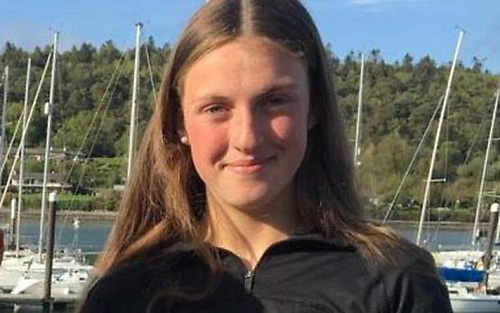 Eve McMahon - an honour and a privilege to be training alongside Annalise Murphy
Eve McMahon - an honour and a privilege to be training alongside Annalise Murphy
Eve McMahon: “I had an amazing opportunity to sail and train with the Olympic Radial Development Team. Training alongside the Olympic medallist Annalise Murphy was both an honour and a privilege for me and gave me tremendous inspiration and experience which helped me enormously during the run up to the 1st Olympic trial - Senior World Championships in Melbourne last February. The trial selection process was interrupted by the Covid 19 world pandemic, which nobody could have foreseen. Annalise was a whisker away from winning that World Championship. I fully support her selection and wish her the very best of luck in her Tokyo campaign and have great confidence that she has what it takes to bring back the gold medal for Irish sailing.”
The Heat Is On For Ireland’s Quartet Of Laser Radial Sailors Competing For Tokyo Olympic Spot
In her latest column for The Irish Times, athletics great Sonia O’Sullivan meets the four women in contention for Ireland’s sole Laser Radial spot at the Olympic Games in Tokyo this summer.
After frustrations in her attempt to qualify in the two-handed 49erFX class, Annalise Murphy is back in the boat with which she won silver at the 2016 Olympics — Ireland’s strongest Olympic sailing result to date.
But this time there is tough competition from three women who were still coming up when she was racing for that medal in Rio — namely Aisling Keller, Aoife Hopkins and 15-year-old Eve McMahon.
All four have been training together in Melbourne, Australia since the start of the year, ahead of the Laser Radial World Championship (starting tomorrow, Friday 21 February) which will be the first of three chances between now and April for one of them to secure that coveted spot.
“Think about how that must be for them,” writes Sonia. “They know that only one of them will go to Tokyo so they wouldn’t be human if they didn’t have some sort of selfish instinct in them. It would be only natural for them to keep little bits and pieces that they’re learning back for themselves to give them a better chance of being the one who gets the spot on the boat.
“But they also know that the more they push each other, the better they make each other. And the better they make each other, the greater chance of a medal for Ireland and a better all round result for Irish sailing.”
Sonia also gets out on the water with Annalise to experience first-hand the speed and excitement of the Laser Radial — and the rush Annalise and her fellow challengers will be feeling when the training is done and the race is on.
Howth Radial Sailor Aoife Hopkins Gets Mercedes Benz Support for Tokyo Trial
21-year-old Olympic sailing hopeful, Aoife Hopkins will attempt to qualify for the forthcoming 2020 Olympic Games in Tokyo this month and is supported in her bid by Mercedes-Benz.
From Howth, Aoife has been sailing since the age of nine and has held the Women’s Laser Radial Irish national champion and under-21 European champion titles, amongst other accolades.
The first of three Olympic trials for Irish selection, the World Championships, will see Aoife compete in Melbourne, Australia.
While sailing is the main priority at the moment, balancing study and sport is a talent Aoife has learned to master over the years. Recently, the Howth Yacht Club star became a University College Dublin financial maths student, having previously studied at Trinity College Dublin for two years.
With just two races remaining at the Laser Radial World Championships in Sakaiminato, Japan to be sailed on Wednesday, both Irish Olympic campaigners are within reach of the single Irish qualification place for Tokyo 2020. Ten nation places are being decided this week.
Aoife Hopkins (Howth, Co. Dublin) moved up a place after the penultimate day’s racing to 41st place while team-mate Aisling Keller (Nenagh, Co. Tiperary) slipped down the standings from 40th to 49th.
However, Hopkins’ overall position equates to fifth nation while Keller’s result would be tenth nation: mathematically, it is still possible that both sailors could slip outside the criteria on the final day.
The Howth sailor was disqualified for premature starting in the opening race of the day though sailed the course amongst the leading boats. She then scored a 25th in the race that followed while using the single discard to drop the earlier disqualification.
Meanwhile, her team-mate from Lough Derg sailed well in the opening stages of both races but suffered on the downwind legs as conditions were the freshest of the series so far.
“Aoife did exactly what she needed to do after the disqualification - get stuck in and get a good result,” said Rory Fitzpatrick, Irish Sailing’s Head Coach. “Her confidence and momentum are growing with the experience of racing at this level.”
Two final races are scheduled for Wednesday (early-morning Irish time) that will decide the world championship that is currently led by Denmark’s Anne-Marie Rindom.
Subject to qualification for Tokyo 2020 at this opportunity, a selection trial series will follow next year. A further qualification opportunity also exists for European nations in Genoa in April.
Genoa will also be the qualification opportunity for the men’s single-handed Laser event while Ireland’s skiff sailors will seek qualification for the Olympics at the 49er and 49erFX men and womens’ world championships in New Zealand in November.
Results are here
Both Aisling Keller (Nenagh, Co. Tipperary) and Aoife Hopkins (Howth, Co. Dublin) qualified for the Gold fleet final round at the Laser Radial World Championship at Sakaiminato, Japan earlier today (Sunday 21st July 2019).
The event is the penultimate qualification regatta for the Tokyo 2020 Olympics in the women's single-handed event sailed in the Radial.
After two days of light winds that put the championship behind schedule, the fleet had a protracted third day afloat for eight hours as the organisers staged three races to catch-up on most of the event schedule.
Both Keller and Hopkins had two good results apiece with an eighth and an eleventh respectively that leaves them 29th and 37th overall at the end of the qualification series for the 111-boat event.
A six-race Gold fleet series begins on Monday with two races scheduled daily before concluding the world championship on Wednesday.
A total of ten-nation places are available from the world championship for Tokyo with 14 countries in the Gold fleet all seeking one of the quota. Both Keller and Hopkins are currently inside the qualification standings.
"It was a challenging day to be consistent with winds ranging from fresh to moderate to light but flukey at all times," commented Rory Fitzpatrick, Irish Sailing's Head Coach. "The plan continues to be to sail one race at a time as a very tough Gold fleet final round lies ahead."
Results are here




























